#kimbel and cabus
Text

Cabinet 1875
Kimbel and Cabus
Cabinets such as this one are representative of the opulent consumption of the Gilded Age. Although equipped with doors and shelves in the sides, the primary function of this cabinet was not storage but display—a lavish pedestal for costly works of art. With its graceful, curved sides, the cabinet follows the form of large Renaissance-inspired furniture pieces that were introduced and popularized at the international exhibitions of the 1850s. It combines painted, carved, marquetried, incised, and gilt decorations representing some of the most costly and time-consuming methods used to craft furniture. Aside from the space intended to hold a sculpture, no surface was left undecorated.
High Museum
52 notes
·
View notes
Video
In honor of the final week to view Modern Gothic: The Inventive Furniture of Kimbel and Cabus, 1863–82, we’re highlighting some of the geometric, visually arresting pieces that fill this exhibition.
Like this 1875 corner chair, which was reupholstered by a team of curators, scholars, conservators, and artisans. See the period-specific process on our YouTube channel and come see these pieces in-person through February 13.
Watch the full video
Get tickets
#brooklyn museum#brooklyn#museum#anton kimbel#joseph cabus#kimbel and cabus#furniture#furniture design#nineteenth century art#restoration
42 notes
·
View notes
Text
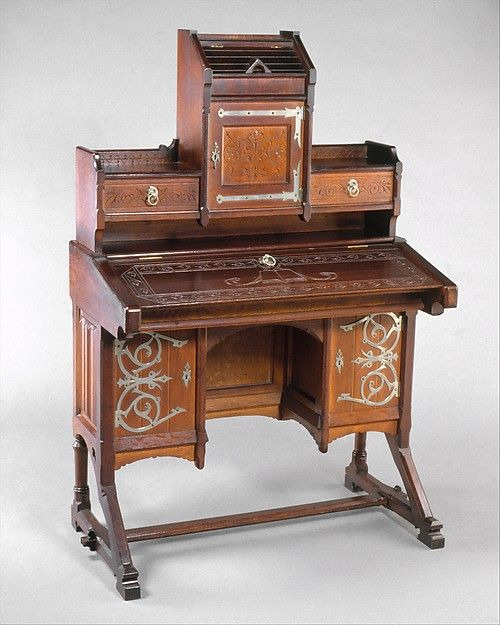
A. Kimbel and J. Cabus | Desk | American | The Metropolitan Museum of Art
This desk embodies the Modern Gothic style prescribed by English and American design reformers beginning in the late 1860s. The firm of A. Kimbel & J. Cabus worked extensively in this mode throughout the 1870s, incorporating such Gothic elements as pointed gables, trestle feet, incised linear decoration, and elaborate strap hinges into a large stock of furniture displayed in their showrooms at 7 and 9 East Twentieth Street.
36 notes
·
View notes
Photo
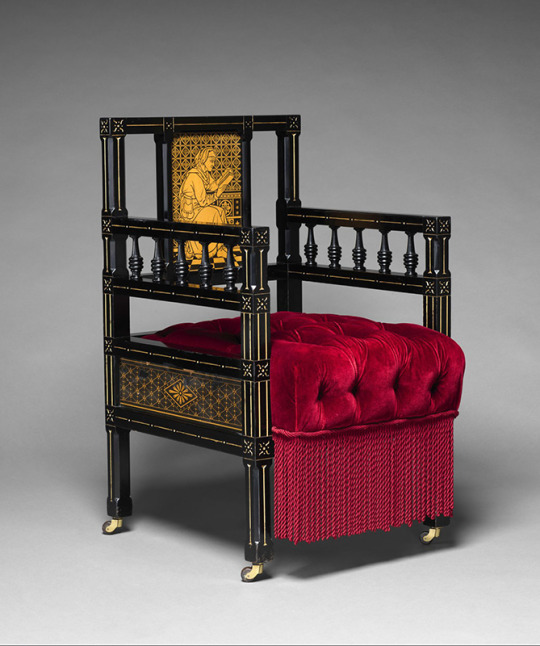
Armchair by Kimbel and Cabus, New York, c. 1875. Ebonized cherry, gilding, paper tiles, modern textile.
The Magazine Antiques / The Metropolitan Museum of Art
41 notes
·
View notes
Photo
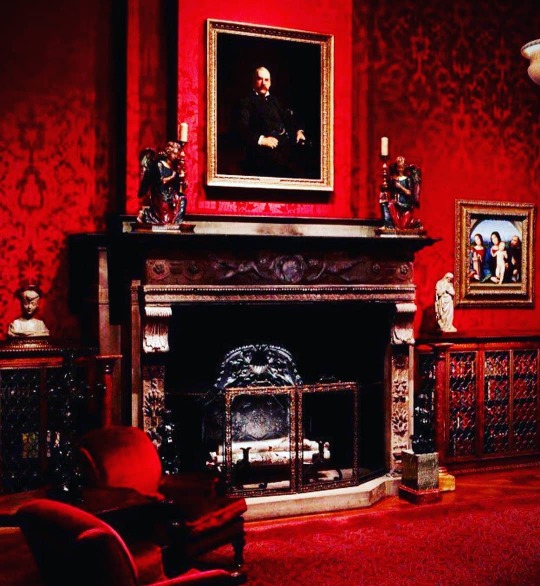
🕍Gothic Fireplace🕍 Modern Gothic, also known as Reformed Gothic, was an Aesthetic Movement style of the 1860s and 1870s in architecture, furniture and decorative arts, that was popular in Great Britain and the United States. A rebellion against the excessive ornament of Second Empire and Rococo Revival furniture, it advocated simplicity and honesty of construction, and ornament derived from nature. Unlike the Gothic Revival, it sought not to copy Gothic designs, but to adapt them abstract them, and apply them to new forms. The style's leading advocates were English designers Christopher Dresser and Charles Eastlake. Eastlake's Hints on Household Taste, Upholstery, and Other Details, published in England in 1868 and in the United States in 1872, was one of the most influential decorating manuals of the Victorian Era. The Eastlake Movement argued that furniture and decor in people's homes should be made by hand or by machine-workers who took personal pride in their work. Eastlake lectured in the United States in 1876. French architect Eugène Viollet-le-Duc advocated similar principles in Entretiens sur l'architecture (in 2 volumes, 1863–72), which was translated and published in the United States as Discourses on Architecture (1875). He incorporated modern materials, such as cast iron, into his historicist designs and building restorations. He also designed furniture. Other designers who worked in the Modern Gothic style include Bruce James Talbert, Edward William Godwin, and Thomas Jeckyll in England; and Kimbel and Cabus, Frank Furness, and Daniel Pabst in the United States. The style's parting zenith was the Modern Gothic furniture exhibited at the 1876 Centennial Exposition in Philadelphia. https://www.instagram.com/p/CFavVj1H_rA/?igshid=w7ot497f9ujj
0 notes
Photo
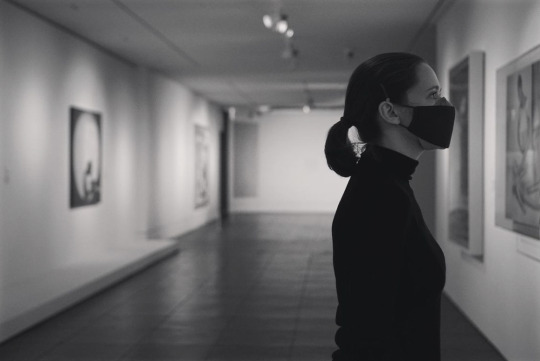
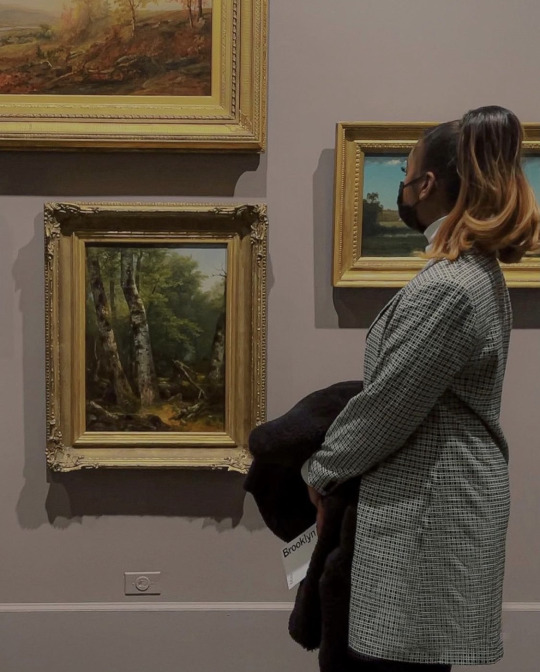
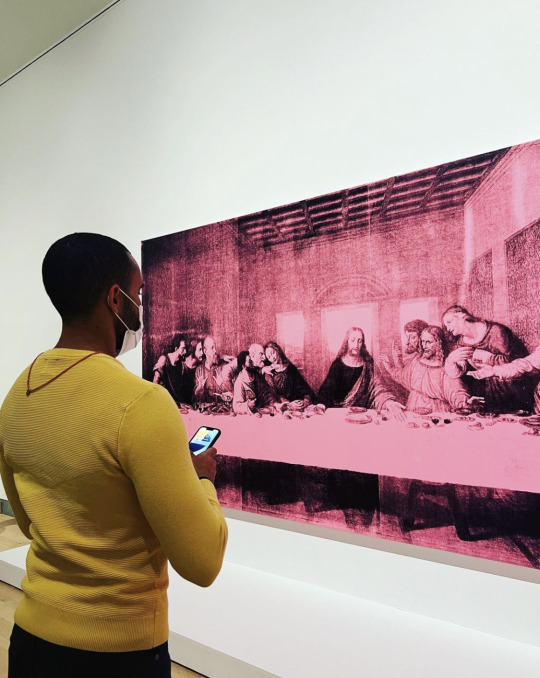

The proof is in the profile, no one has a bad side at the Brooklyn Museum.
Don't forget that your tickets to special exhibitions, like #DiorDesignerofDreams and #WarholRevelation, include general admission. So be sure to explore other exhibits on view including: A Crack in the Hourglass, An Ongoing COVID-19 Memorial; Baseera Khan: I Am an Archive; Modern Gothic and more.
Get more information and tickets here.
📷 (on Instagram): @wthlovejp_, @yume_no_mood, @youngbradford, @tybydesign_, @patbits
#Brooklyn Museum#brooklyn#museum#MyBkM#nyc#dior#andy warhol#Baseera Khan#Rafael Lozano-Hemmer#Kimbel and Cabus
34 notes
·
View notes
Photo
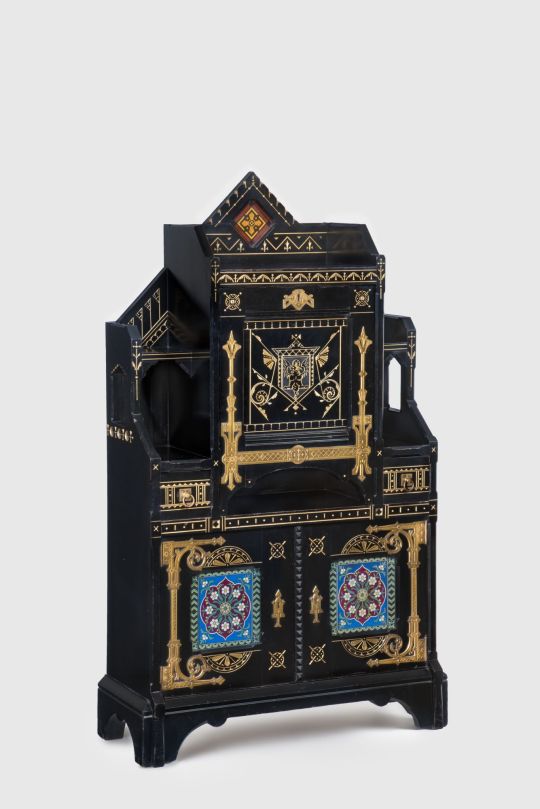
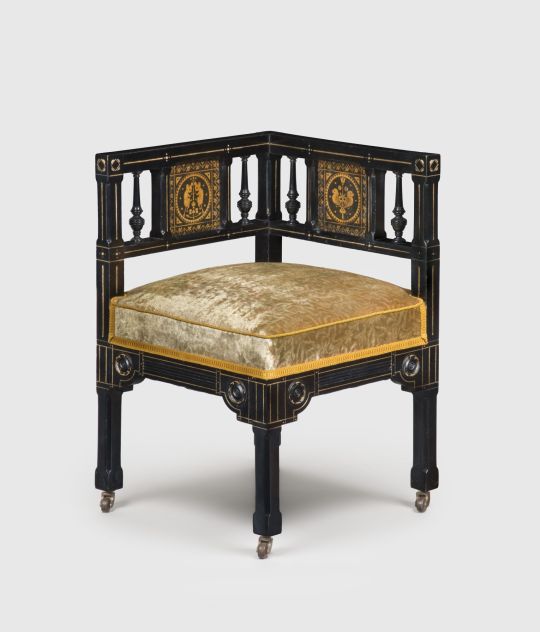
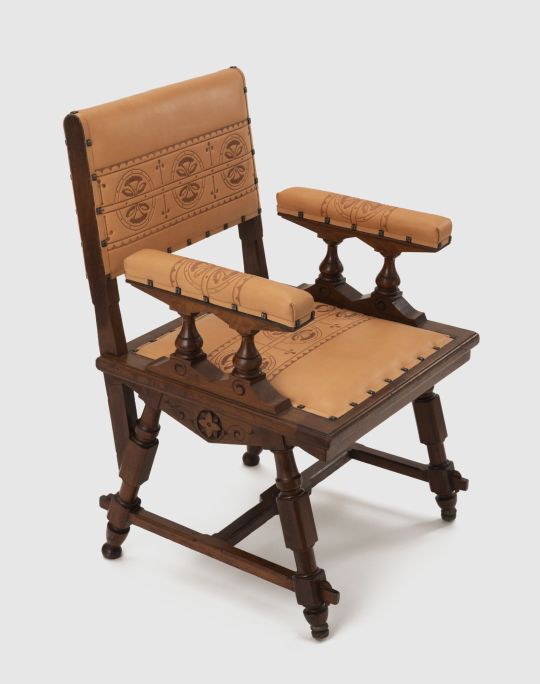
Good morrow, peerless paramours! With one month left to enjoy Modern Gothic: The Inventive Furniture of Kimbel and Cabus, 1862-82, we're leaning into medieval-era inspiration from speech to structural silhouettes.
Featuring over 60 pieces of Kimbel and Cabus' finest furniture and ephemera, this exhibition showcases the expansive energy and adventurous aesthetics for which these timeless collaborators are celebrated.
Plan your visit between now and February 13. Exhibition access is included in General Admission, which is pay-what-you-wish! https://bit.ly/3cFQu1r
Kimbel and Cabus (New York, 1863–82). Cabinet-Secretary, circa 1875. Painted cherry, gilding, copper, brass, leather, earthenware. Brooklyn Museum; Bequest of DeLancey Thorn Grant in memory of her mother, Louise Floyd-Jones Thorn, by exchange, 1991.126. (Photo: Gavin Ashworth) ⇨ Kimbel and Cabus (New York, 1863–82). Corner Chair, circa 1875. Painted soft maple, paper, gilding, copper alloy, rubber, modern textile. Brooklyn Museum; Bequest of DeLancey Thorn Grant in memory of her mother, Louise Floyd-Jones Thorn, by exchange, 1992.9. (Photo: Gavin Ashworth) ⇨ Kimbel and Cabus (New York, 1863–82). Armchair, circa 1875. American black walnut, leather. Collection of Andrew VanStyn. (Photo: Mitro Hood)
#brooklyn museum#design#furniture#modern gothic#nineteenth century art#anton kimbel#joseph cabus#kimbel and cabus#museum#furniture design
45 notes
·
View notes
Photo
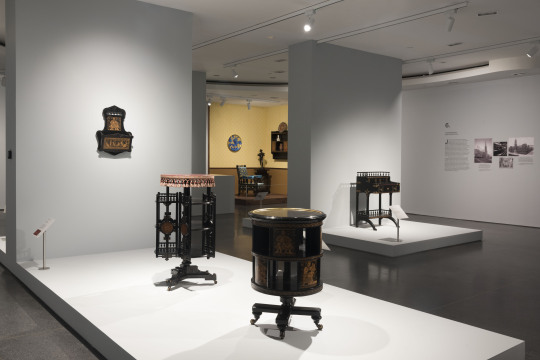
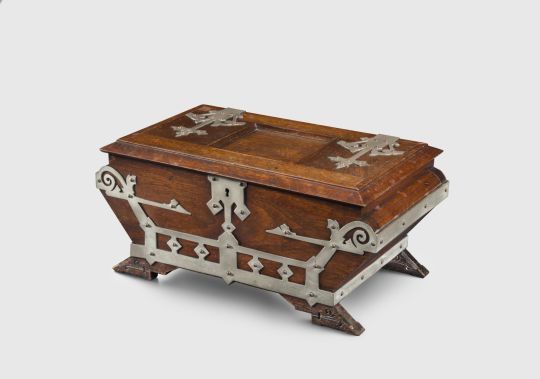

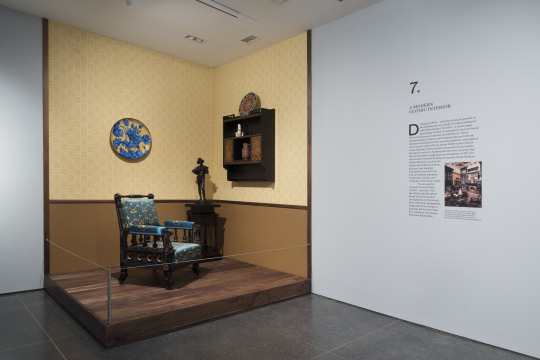
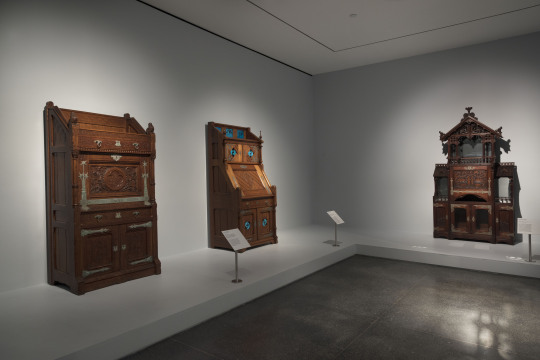
Kimbel and Cabus created a signature style in designing furniture with bold rectilinear forms, incised geometric and abstract botanical decoration, and medieval-style metal hardware. But did you know they were also among the first commercial designers to use photography to sell furniture?
During #ArtistsEye this Saturday at 2 pm, guests will get a chance to explore the gallery and discuss the many inventive aspects of this pivotal partnership.
Get your ticket for an excellent event before this exhibit closes next month (February 13): https://bit.ly/3rqF73M
Artist’s Eye: Modern Gothic
📷 (1, 3, 5): Jonathan Dorado
Kimbel and Cabus (New York, 1863–82). Humidor, circa 1875. American black walnut, brass-plated nickel. Brooklyn Museum; Purchase gift of Deedee and Barrie Wigmore, 2017.7. (Photo: Gavin Ashworth) ⇨ Kimbel and Cabus (New York, 1863–82). Table, circa 1875. Ebonized wood, paper, gilding, metal. Collection of Barrie and Deedee Wigmore. (Photo: Gavin Ashworth)
#brooklyn museum#brooklyn#museum#anton kimbel#joseph cabus#kimbel and cabus#furniture#design#event#nyc
19 notes
·
View notes
Photo
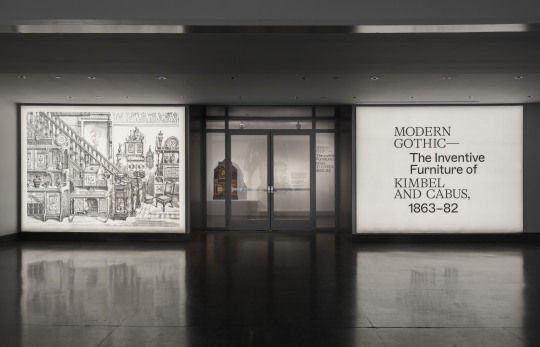
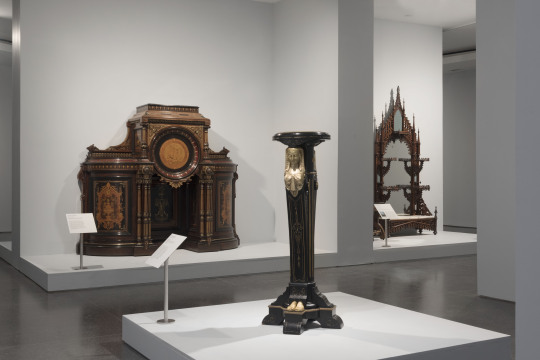
The word “Gothic” evokes numerous associations. In architecture, it’s commonly linked with the medieval-era cathedrals of Western Europe. During the late eighteenth and early nineteenth centuries, Gothic fiction arose with novels such as Mary Shelley’s Frankenstein (1818). During the same time, a revived interest in the Gothic era flourished in Great Britain, and the resulting revival style incorporated fanciful aspects of Gothic architecture and aesthetics into building, interior, and furniture designs.
This spooky season, we’ll be exploring elements of the Modern Gothic design movement, as seen in the work of Kimbel and Cabus—one of New York City’s leading furniture and decorating firms of the nineteenth century.
You can see this work on view in Modern Gothic: The Inventive Furniture of Kimbel and Cabus, 1863–82, through February 13.
#modern gothic#kimbel and cabus#furniture#decoration#cathedrals#Gothic#spooky season#architecture#aesthetics#brooklyn museum#bkmdecarts
47 notes
·
View notes
Photo



Small bites and special access all while sipping wine? Get your ticket to Thursday’s Art History Happy Hour where we’ll discuss the innovation and influence of Kimbel and Cabus that would inevitably become synonymous with Modern Gothic furniture-making and design.
Tickets are available for $45 – $40 for Members. #ArtHistoryHappyHour
https://bit.ly/3FH1uaq
Photos by Jonathan Dorado
#brooklyn museum#brooklyn#museum#art#furniture#furniture design#joseph cabus#anton kimbel#kimbel and cabus#nineteenth century art#nyc
14 notes
·
View notes
Photo
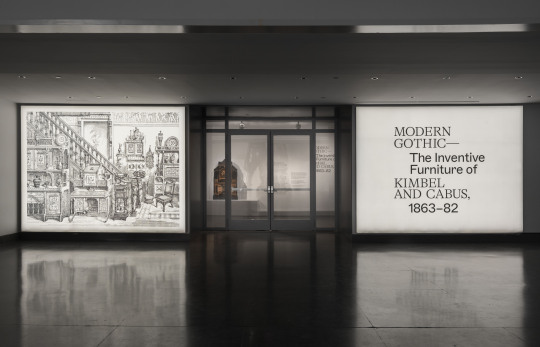
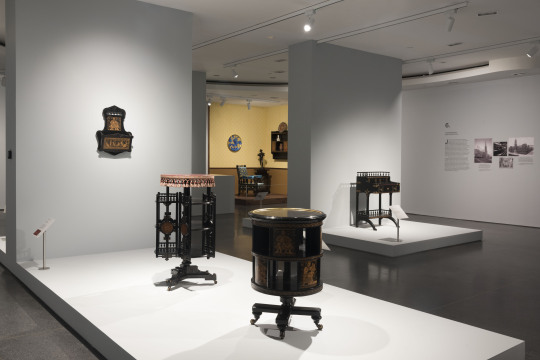

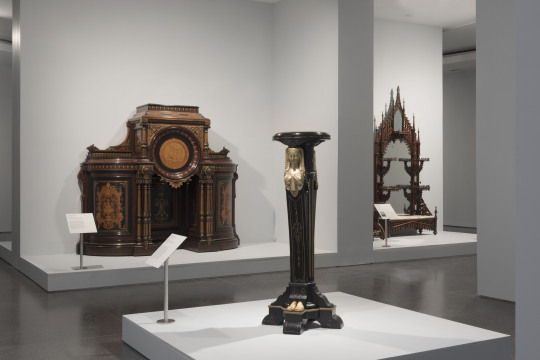
Modern Gothic: The Inventive Furniture of Kimbel and Cabus, 1863–82 is now on view! Visit us through February 13 to experience the first museum exhibition to trace Kimbel and Cabus's American success story with new scholarship and primary sources, offering fresh insight into the history of the enterprising design team, their ambitious marketing practices, and their forward-looking clientele.
#bkmdecarts#decorative arts#modern gothic#kimbel and cabus#furniture#design#american design#gothic#brooklyn museum
15 notes
·
View notes
Photo
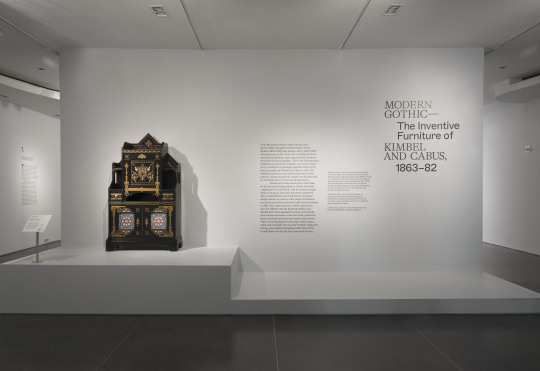
Next Saturday at 2 pm, Norman Teague of Norman Teague Design Studios will lend his perspective and lead guests through the inventive nineteenth-century furniture designs of Anton Kimbel and Joseph Cabus.
Join in on this gallery walk where there will be plenty of talk focusing on the exhibition’s expansion of design history and how Kimbel and Cabus’s work pushed against the norm to create something new. Get your tickets here. #ArtistsEye
https://bit.ly/3rqF73M
Photo by Jonathan Dorado.
#brooklyn museum#anton kimbel#joseph cabus#museum#art#furniture#brooklyn#nyc#design#nineteenth century art#kimbel and cabus
6 notes
·
View notes
Photo
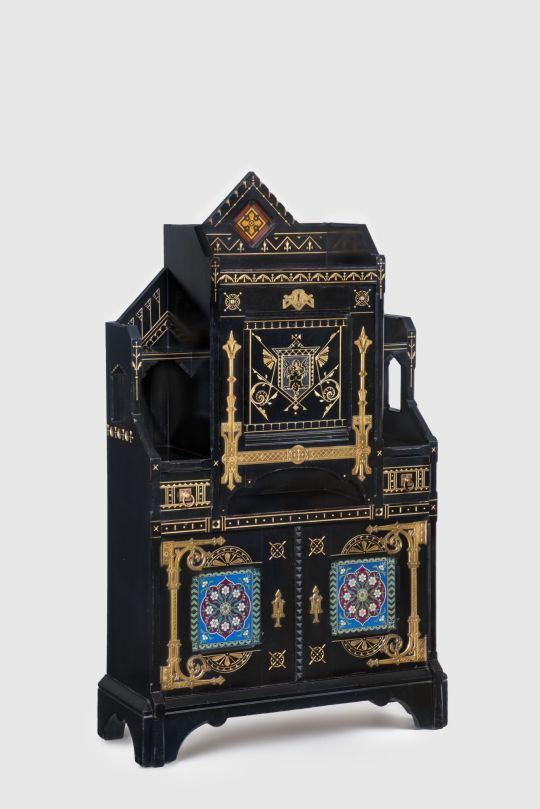
We're excited to share news about our upcoming exhibition Modern Gothic: The Inventive Furniture of Kimbel and Cabus, 1863–82. Over the course of their partnership, Anton Kimbel (1822–1895) and Joseph Cabus (1824–1898) developed one of New York City's leading furniture and decorating firms and defined a new take on Modern Gothic design, a style that originated in Britain and was embraced by a growing middle class in the post–Civil War United States.
Opening July 2, Modern Gothic is the first museum exhibition to trace the duo's American success story with new scholarship and primary sources, offering fresh insight into the history of the enterprising design team, their ambitious marketing practices, and their forward-looking clientele. The exhibition includes rare examples of furniture from their famous chair designs and dramatic, monumental desks to their quirky, smaller forms decorated with fanciful paper panels, as well as books and ephemera.
Kimbel and Cabus (New York, 1863–82). Cabinet-Secretary, circa 1875. Painted cherry, gilding, copper, brass, leather, earthenware. Brooklyn Museum; Bequest of DeLancey Thorn Grant in memory of her mother, Louise Floyd-Jones Thorn, by exchange, 1991.126. (Photo: Gavin Ashworth)
#brooklyn museum#anton kimbel#joseph cabus#design#bkmdecarts#bkmdesign#decorative arts#furniture#modern gothic#brooklyn#art#exhibition#design exhibition
98 notes
·
View notes
Photo

The holiday season is here, and we can't wait for our neighbors, near and far, to enjoy our events and exhibitions! Our galleries are brimming with works of art for you to discover—from an intimate look at Andy Warhol's Byzantine Catholic upbringing to the glamorous world of Christian Dior: Designer of Dreams. Plus, learn something new from innovative artists and designers like Baseera Khan, Kimbel and Cabus, and many, many more. Plan your next visit at https://bit.ly/BkMtix.
7 notes
·
View notes
Photo
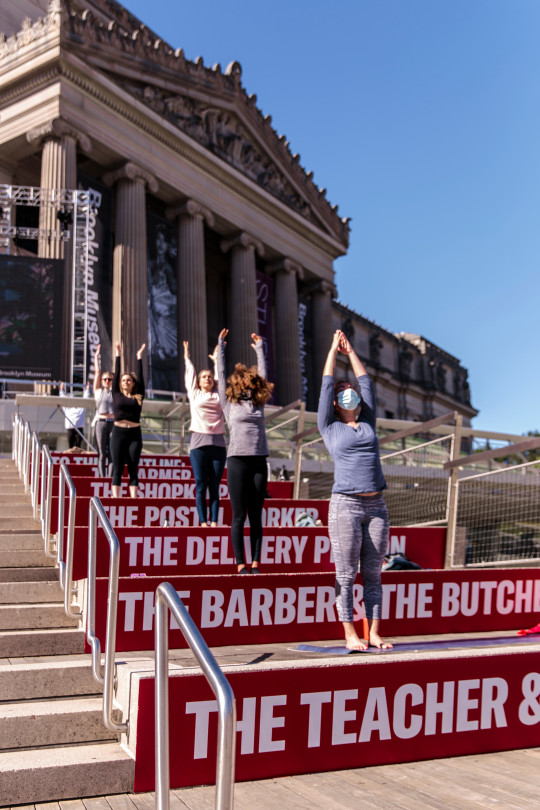
Dear Friends,
Spring is the season for renewal, and rarely has renewal been as important as it is this year, which is why I’m overjoyed by the powerful feeling of rebirth that is palpable at the Brooklyn Museum! And as vaccines bring hope, the team and I are excited for these warmer months when the Museum hosts outdoor events, presents countless opportunities to engage with art in our galleries, and continues to serve our community through expanded partnerships.
Knowing that we all need some fun, we’re here to delight with great outdoor programs. Our popular Yoga on the Stoop promotes wellness and togetherness, and our Drink and Draw series offers life drawing classes in our Steinberg Family Sculpture Garden. We’re excited about our second annual Juneteenth celebration, with free programs focused on Black joy and mental health. As part of our commitment to encouraging our neighbors’ success, this season we’ll grow and deepen partnerships with community organizations, local businesses, and makers through events such as our weekly outdoor Pop-Up Market, which supports artisans producing handmade art, jewelry, fashion, home goods, and more.
We’re also celebrating renewal through healing and learning. Our much-loved Art and Empathy program creates space for connection and community-building. We’ve developed new, free after-school offerings for kids including our weekly BkM Art Hangouts, and in-person Summer Camp. And we remain committed to supporting the healthcare sector, partnering with NYC Health and Hospitals to offer art-based engagement that addresses the trauma and anxiety experienced by frontline workers throughout the pandemic.
Despite the challenges of the past year, we’re proud to have put together a wide-ranging season of exhibitions. We’re featuring many recent acquisitions in the timely exhibition The Slipstream, which examines how artists have reflected upon this moment, tackling far-reaching themes from environmental justice to Black resiliency. We’ll also debut, on the front steps of our plaza, a major new commission by Nick Cave. It honors the importance of truth amid widespread misinformation and was conceived in response to the police killing of George Floyd in summer of 2020. In July, Modern Gothic explores the innovations of Anton Kimbel and Joseph Cabus, two nineteenth-century immigrant furniture designers. And later this summer, Brooklyn will be the second stop on a five-city tour of the incredible and historic presidential portraits of Barack and Michelle Obama, by Kehinde Wiley and Amy Sherald, the first African American artists commissioned to create official portraits of a U.S. President and First Lady. This summer, we’ll also reopen parts of our second floor galleries, which will include a newly reinstalled Arts of Southeast Asia gallery and displays from our Arts of Asia and the Islamic World collections, helping to broaden understanding and conversations around the diversity of artistic practices across Asia. We can’t wait to unveil them!
Part of renewal also means reimagining how we operate. Some days it feels as though there’s hardly an aspect of the Museum that we aren’t examining and changing as we work toward greater equity—from our HR and investment practices and new staff leadership positions focused on diversity and equity to how we make and share exhibitions. Throughout, I’m grateful to our dedicated team who strive every day to make sure our Museum advances at this time of significant upheaval and change. From our security, maintenance, and visitor experience teams who keep us safe and healthy to our staff who shape exciting exhibitions and programs that open our minds and fill our hearts with joy, I’m wowed by their efforts.
As ever, we strive to be the Museum you want and need us to be. So come visit and find inspiration at the Brooklyn Museum!
With warm wishes,
Anne Pasternak
Shelby White and Leon Levy Director
Brooklyn Museum
Participants practice socially distant yoga at Outdoor Yoga on the Stoop, 2020. (Photo: Kolin Mendez)
21 notes
·
View notes
